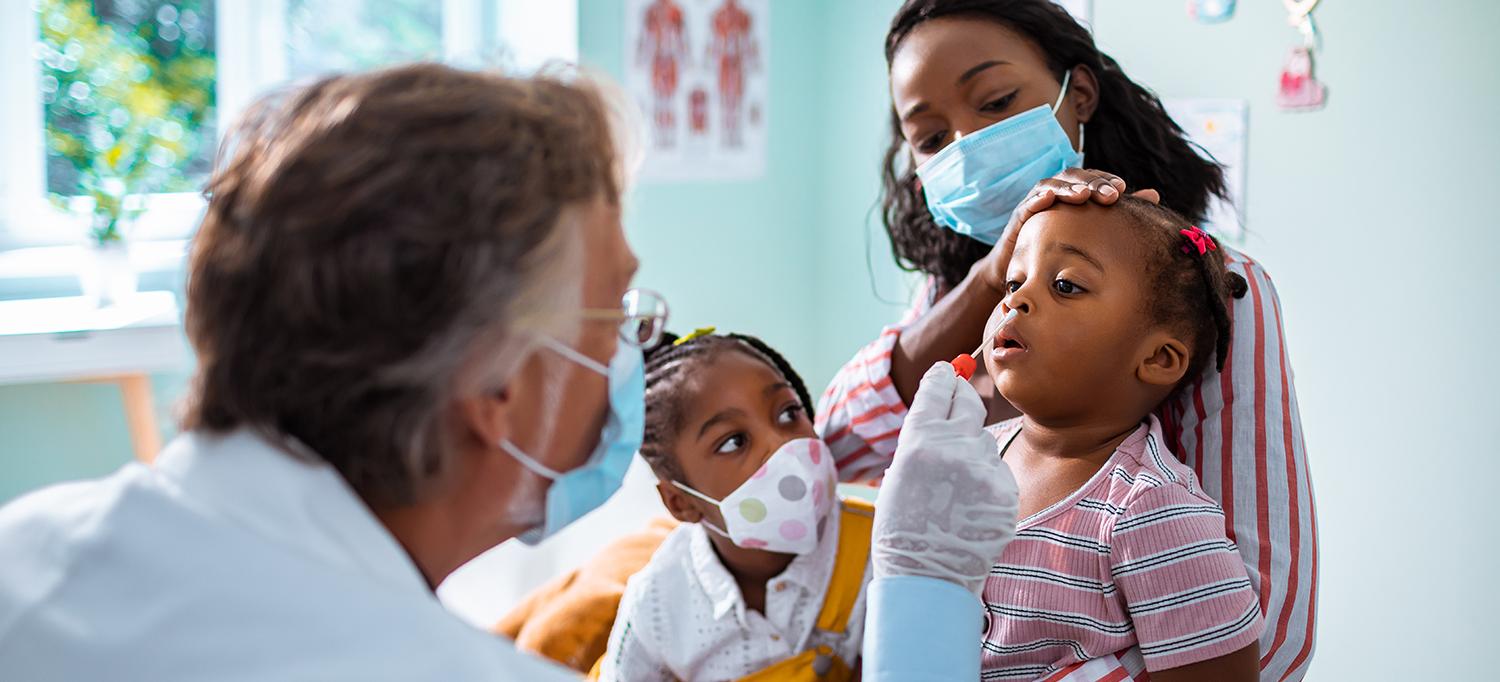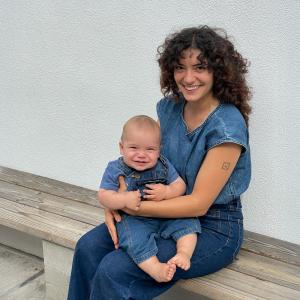
Testing for COVID-19 and the flu, which is done with a quick, painless nasal swab, is recommended for any child showing respiratory symptoms.
Photo: Marko Geber/Getty
With the start of flu season coming in the middle of the coronavirus disease (COVID-19) pandemic, many parents may be worrying about whether their sick child has a cold, the flu, or COVID-19.
Because respiratory illnesses share many of the same symptoms—sore throat, fever, coughing, congestion, and headache, among others—there’s no way to tell which infection your child has without testing. But experts say that knowing is vital to keeping our families, schools, and communities safe, especially with the approach of colder weather and the traditional time for holiday gatherings and travel.
“When we know what the illness is, we can help you know if you need to quarantine and when it’s safe to go back to school,” says Paulo R. Pina, MD, MPH, pediatric medical director at the Family Health Centers at NYU Langone. “Testing can also help ease parents’ minds. It can bring a sense of relief if the result is negative, or if it’s positive, we can provide guidance on how to avoid spreading it further.”
Most children with COVID-19 have mild or no symptoms and recover easily, although some have become severely ill. Generally with children, the concern is that they can spread the disease to people who are at greater risk for severe illness, such as older adults and people with underlying conditions such as heart disease, lung disease, or diabetes.
Testing is the only way to know what illness is affecting your child. “I can’t look at a child and say, ‘you have COVID-19,’ or ‘you have the flu,’” says Jennifer L. Lighter, MD, associate professor in the Department of Pediatrics and a pediatric epidemiologist at Hassenfeld Children’s Hospital at NYU Langone. “That’s why if a child has symptoms, they should be tested.”
Symptoms can start within 2 to 14 days after exposure, but occur most frequently within 5 to 7 days. Similar to the flu, fever and cough are the most common symptoms in children. Nausea, vomiting, and diarrhea are symptoms seen mostly in children and not adults. Additional signs include body aches, fatigue, sore throat, and shortness of breath. The loss of taste or smell is a specific symptom of COVID-19 and not experienced with other respiratory viruses such as influenza or the common cold. Many children have mild symptoms or none at all.
If your child has any of these symptoms, call your pediatrician to determine if testing is recommended. Testing for COVID-19 and the flu can be done with a single nasal swab, with some results available within minutes.
“It’s really important to bring your child in as soon as they show symptoms so they can be tested,” says Sara Siddiqui, MD, pediatrician at NYU Langone Huntington Medical Group. “To keep everyone safe, NYU Langone’s pediatric practices have separate times when we see children who have cold, flu, or COVID-19 symptoms, and we have dedicated exam rooms. Once we know what is making your child sick, we can provide guidance on how to help them feel better.”
To learn more about the differences between the flu, COVID-19, and the common cold, watch our Facebook Live featuring Dr. Lighter and Dr. Siddiqui.
Types of COVID-19 Testing for Children
There are two main types of COVID-19 tests: a diagnostic test and an antibody test. A diagnostic test can detect if your child has an active COVID-19 infection. At NYU Langone, we offer two different types of diagnostic tests for children—rapid antigen testing and polymerase chain reaction (PCR) testing.
An antibody test is used to determine whether your child has had COVID-19 in the past, even if there were no symptoms. An antibody test does not detect a current infection.
Our pediatricians can talk with you about which test should be used and when testing is most helpful.
COVID-19 Rapid Antigen Testing
The rapid antigen test detects not the coronavirus itself, but proteins created by the immune system to counter the virus. For this reason, the rapid antigen test is most accurate when your child is exhibiting symptoms because that is the sign that the body is fighting an infection.
“The antigen test should only be used if a child has active symptoms or a known exposure to COVID-19,” says Dr. Lighter. “The test is most accurate when used during the first week of infection.”
The test can be used on infants and children of any age, and results are available quickly. “The swab is placed in the front of the nose, not way back, and so it’s not disruptive or painful,” says Dr. Pina. “We process the test on-site, and it’s done in less than 20 minutes, so we let you know the results before you leave.”
A positive antigen test result is highly accurate, so it’s safe to say that a positive result means that your child has COVID-19. A negative test result is less reliable, depending on when the test was taken and if your child was displaying symptoms. In some cases, such as if your child lives with people at high risk, or if there is an outbreak in your community, your pediatrician might recommend a follow-up PCR test to confirm a negative result. Talk with your pediatrician about whether follow-up testing is needed for a negative test result.
COVID-19 PCR Testing
The PCR test is performed with a nasal swab or a saliva sample. But unlike the antigen test, the PCR test is looking for the virus itself—not the body’s immune response to it. This makes the PCR test much more sensitive because it can detect virus at multiple stages of the infection, from early on before there are symptoms, to later on when the illness is over but some virus remains.
“A positive PCR test result doesn’t necessarily mean that your child is currently sick or contagious,” Dr. Lighter says. “But it does mean that your child was exposed at some point, and it’s possible other people in the home were exposed, or are at risk of exposure.”
PCR test results are usually available within one to two business days.
COVID-19 Antibody Testing
A blood test is used to detect COVID-19 antibodies. These are proteins that the body’s immune system used to fight off the infection, and that it might still be producing in order to protect itself from any future encounter with the virus.
“There’s still a lot we don’t know about COVID-19 antibodies,” says Dr. Lighter. “We don’t know if having antibodies means a child is protected against future illness. So while it might be interesting to know if your child has been exposed to COVID-19, no one can say that prior exposure protects against future illness.”
Like the PCR test, antibody test results are not immediate and are usually available within one to two business days.
Managing a Positive COVID-19 Test Result
If your child receives a positive test result for COVID-19, whether through the rapid antigen or PCR test, health experts recommend the following steps:
- As much as is possible, isolate your child from anyone in the household who is at high risk of severe COVID-19 illness. This includes anyone who is immune-compromised and senior citizens.
- Inform your child’s school, day care, sports team, and anyone who has had close contact to your child so that people who have been exposed can get tested.
- Keep your child home for 10 days after the positive test.
- Wear masks while at home. This includes everyone who is in the house, as well as the sick child, if possible.
- Encourage frequent hand washing.
- Clean and disinfect high-touch surfaces such as doorknobs.
- Monitor everyone in the household for symptoms, and seek medical care when needed.
Take care of a child with COVID-19 in much the same way you would if they had a cold or the flu: rest, fluids, and an over-the-counter fever reducer such as ibuprofen or acetaminophen. Most children recover well from COVID-19. But if your child’s symptoms worsen, contact your pediatrician for guidance. Don’t delay seeking care if your child develops difficulty breathing, bluish lips, or another dangerous symptom of infection.
Where to Get Your Child Tested
A combined rapid COVID-19 antigen and flu test for children is available for patients at select NYU Langone pediatric care locations.
PCR and antibody testing is available at NYU Langone hospital testing sites and can be ordered by an NYU Langone pediatrician and scheduled through your child’s NYU Langone Health MyChart account. Testing is also available through local health departments and public hospital systems, including NYC Health + Hospitals.

